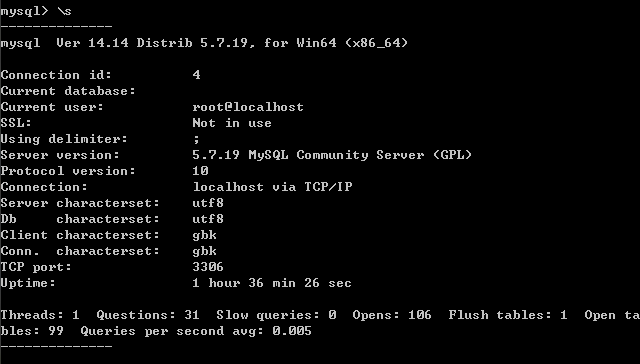第三篇:表相关操作
http://www.cnblogs.com/linhaifeng/articles/7232894.html
注意的几点: 1.如果你在cmd中书命令的时候,输入错了就用\c跳出

2.\s查看配置信息

一 存储引擎介绍
存储引擎即表类型,mysql根据不同的表类型会有不同的处理机制
详见:http://www.cnblogs.com/linhaifeng/articles/7213670.html
二 表介绍
表相当于文件,表中的一条记录就相当于文件的一行内容,不同的是,表中的一条记录有对应的标题,称为表的字段

id,name,qq,age称为字段,其余的,一行内容称为一条记录
三 创建表
#语法: create table 表名( 字段名1 类型[(宽度) 约束条件], 字段名2 类型[(宽度) 约束条件], 字段名3 类型[(宽度) 约束条件] ); #注意: 1. 在同一张表中,字段名是不能相同 2. 宽度和约束条件可选 3. 字段名和类型是必须的

MariaDB [(none)]> create database db1 charset utf8; MariaDB [(none)]> use db1; MariaDB [db1]> create table t1( -> id int, -> name varchar(50), -> sex enum('male','female'), -> age int(3) -> ); MariaDB [db1]> show tables; #查看db1库下所有表名 MariaDB [db1]> desc t1; +-------+-----------------------+------+-----+---------+-------+ | Field | Type | Null | Key | Default | Extra | +-------+-----------------------+------+-----+---------+-------+ | id | int(11) | YES | | NULL | | | name | varchar(50) | YES | | NULL | | | sex | enum('male','female') | YES | | NULL | | | age | int(3) | YES | | NULL | | +-------+-----------------------+------+-----+---------+-------+ MariaDB [db1]> select id,name,sex,age from t1; Empty set (0.00 sec) MariaDB [db1]> select * from t1; Empty set (0.00 sec) MariaDB [db1]> select id,name from t1; Empty set (0.00 sec)

MariaDB [db1]> insert into t1 values -> (1,'egon',18,'male'), -> (2,'alex',81,'female') -> ; MariaDB [db1]> select * from t1; +------+------+------+--------+ | id | name | age | sex | +------+------+------+--------+ | 1 | egon | 18 | male | | 2 | alex | 81 | female | +------+------+------+--------+ MariaDB [db1]> insert into t1(id) values -> (3), -> (4); MariaDB [db1]> select * from t1; +------+------+------+--------+ | id | name | age | sex | +------+------+------+--------+ | 1 | egon | 18 | male | | 2 | alex | 81 | female | | 3 | NULL | NULL | NULL | | 4 | NULL | NULL | NULL | +------+------+------+--------+
注意注意注意:表中的最后一个字段不要加逗号
切换到文件夹下:use db1 增:create table t1(id int,name char(10)) engine=innodb; 删:drop table t1; 改:alter table t1 add age int; alter table t1 modify name char(12); 查:show tables; #查看所有表 show create table t1; #查看t1表 desc t1;#查看表结构 show create table t1\G; #查看表详细结构,可加\G select * from t1; #查看所有的表数据
四 查看表结构
MariaDB [db1]> describe t1; #查看表结构,可简写为desc 表名 +-------+-----------------------+------+-----+---------+-------+ | Field | Type | Null | Key | Default | Extra | +-------+-----------------------+------+-----+---------+-------+ | id | int(11) | YES | | NULL | | | name | varchar(50) | YES | | NULL | | | sex | enum('male','female') | YES | | NULL | | | age | int(3) | YES | | NULL | | +-------+-----------------------+------+-----+---------+-------+ MariaDB [db1]> show create table t1\G; #查看表详细结构,可加\G
五 数据类型
http://www.cnblogs.com/linhaifeng/articles/7233411.html
六 表完整性约束
http://www.cnblogs.com/linhaifeng/articles/7238814.html
七 修改表ALTER TABLE
语法: 1. 修改表名 ALTER TABLE 表名 RENAME 新表名; 2. 增加字段 ALTER TABLE 表名 ADD 字段名 数据类型 [完整性约束条件…], ADD 字段名 数据类型 [完整性约束条件…]; ALTER TABLE 表名 ADD 字段名 数据类型 [完整性约束条件…] FIRST; ALTER TABLE 表名 ADD 字段名 数据类型 [完整性约束条件…] AFTER 字段名; 3. 删除字段 ALTER TABLE 表名 DROP 字段名; 4. 修改字段 ALTER TABLE 表名 MODIFY 字段名 数据类型 [完整性约束条件…]; ALTER TABLE 表名 CHANGE 旧字段名 新字段名 旧数据类型 [完整性约束条件…]; ALTER TABLE 表名 CHANGE 旧字段名 新字段名 新数据类型 [完整性约束条件…];
操作文件的一行行内容(记录)
增:insert into db1.t1 values(1,'haiyan'),(2,'yaling'),(3,'xiaoxiao'); #如果t1不给参数,默认按照位置参数依次传参 删:delete from t1 where id = 2; #对于清空记录有两种方式,但是推荐后者 delete from t1; truncate t1; #当数据量比较大的情况下,使用这种方式,删除速度快 改:update t1 set name = 'SB' where id=3; update t1 set name= 'SB' where name = 'xiaoxiao'; alter table t7 modify id int primary key auto_increment; 修改id为主键并且自增 查:select * from t1; #查看t1里所有的数据 select name from t1; #查看t1里所有的name select id,name from t1; #查看t1里所有的id,name
自增id的方法
create table t5(id int primary key auto_increment,name char(10)); #create table t4(id int not null unique auto_increment,name char(10)); (不空且是唯一的)#这个和上面的是一回事 insert into xx(name) values ('haiyan1'), ('haiyan2'), ('haiyan3'), ('haiyan4'), ('haiyan5');
示例: 1. 修改存储引擎 mysql> alter table service -> engine=innodb; 2. 添加字段 mysql> alter table student10 -> add name varchar(20) not null, -> add age int(3) not null default 22; mysql> alter table student10 -> add stu_num varchar(10) not null after name; //添加name字段之后 mysql> alter table student10 -> add sex enum('male','female') default 'male' first; //添加到最前面 3. 删除字段 mysql> alter table student10 -> drop sex; mysql> alter table service -> drop mac; 4. 修改字段类型modify mysql> alter table student10 -> modify age int(3); mysql> alter table student10 -> modify id int(11) not null primary key auto_increment; //修改为主键 5. 增加约束(针对已有的主键增加auto_increment) mysql> alter table student10 modify id int(11) not null primary key auto_increment; ERROR 1068 (42000): Multiple primary key defined mysql> alter table student10 modify id int(11) not null auto_increment; Query OK, 0 rows affected (0.01 sec) Records: 0 Duplicates: 0 Warnings: 0 6. 对已经存在的表增加复合主键 mysql> alter table service2 -> add primary key(host_ip,port); 7. 增加主键 mysql> alter table student1 -> modify name varchar(10) not null primary key; 8. 增加主键和自动增长 mysql> alter table student1 -> modify id int not null primary key auto_increment; 9. 删除主键 a. 删除自增约束 mysql> alter table student10 modify id int(11) not null; b. 删除主键 mysql> alter table student10 -> drop primary key;
八 复制表
复制表结构+记录 (key不会复制: 主键、外键和索引) mysql> create table new_service select * from service; 只复制表结构 mysql> select * from service where 1=2; //条件为假,查不到任何记录 Empty set (0.00 sec) mysql> create table new1_service select * from service where 1=2; Query OK, 0 rows affected (0.00 sec) Records: 0 Duplicates: 0 Warnings: 0 mysql> create table t4 like employees;
create table t7(id int,name char(10)); create table t8 select * from t7; #拷贝表结果(如果有数据就把数据一起拷贝了) create table t8 select * from t5 where 1=2; #拷贝表结构,不拷贝表数据(条件为假时,查不到任何记录) alter table t7 modify id int primary key auto_increment; 修改id为主键并且自增 insert into t7(name) values ('egon1'), ('egon1'), ('egon1'), ('egon1');
九 删除表
DROP TABLE 表名;
创建账号
8.select user()#查看当前用户 select * from mysql.user; 查看所有的用户 9.创建账号 identifity create user 'haiyan'@'localhost' identified by '147852' # 名为haiyan的本机账号 create user 'alex'@'%' identified by '123' #代表只要ip地址能拼通,那么所有的用户都可以远程登录alex create user 'susan'@'192.168.20.%' identified by '123' #创建远程账号,只要是192.168.20.?开头的ip都可以登录susan #如果你要远程登录alex的账户,那么客户端得这样登录 :mysql -h192.168.20.97 -ualex -p123
数据库的权限操作
#insert ,select ,update,delete #有这么几个可以设置权限的操作,那么我们先以select为例吧。 分四个级别: 级别1:对所有的库,下的所有的表,下的所有的字段 '''*.*代表所有的库下的所有的表''' 同意select权限开放,开放的是*.*的select权限开放给用户 grant select on *.* to 'zhang'@'localhost' identified by '123'; #让创建用户的时候赋予权限 级别2:对db1库,下的所有的表,下的所有的字段 grant select on db1.* to 'wang'@'localhost' identified by '123'; 级别3:对表db1.t1,下的多有字段 grant select on db1.t1 to 'li'@'localhost' identified by '123'; 级别4:对表db1.t1,下的id,name,字段 grant select (id ,name) on db1.t1 to 'zhao'@'localhost' identifitied by '123'; grant select (id ,name),update(name) on db1.t1 to 'zhao'@'localhost' identifitied by '123'; 修改完权限后要记得刷新权限 flush privileges; 删除权限: revoke select on *.* from 'zhang'@'localhost' revoke select on db1.* from 'wang'@'localhost' revoke select on db1.t1 from 'li'@'localhost' revoke select (id ,name),update(name) on db1.t1 from 'zhao'@'localhost'





